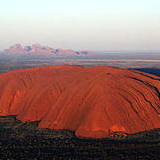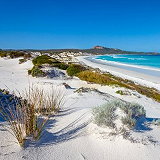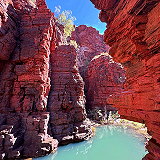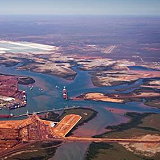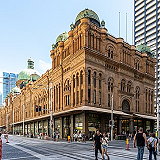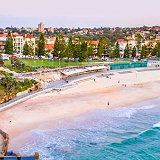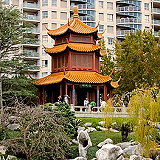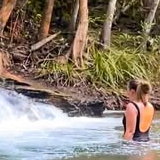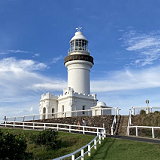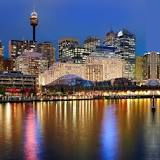| Tjoritja MacDonnell National Park | |
| Tjoritja / West MacDonnell National Park stretches 161 km west of Alice Springs and 1,234 km south of Darwin. The park stretches along the MacDonnell Ranges, west of Alice Springs. Explore and enjoy the scenic beauty and history of the area by hiking, swimming in the lakes, or pitching a tent for a longer stay. | |
| Tiwi Islands | |
| The Tiwi Islands are part of the Northern Territory, Australia, 80 km (50 mi) to the north of Darwin adjoining the Timor Sea. They comprise Melville Island, Bathurst Island, and nine smaller uninhabited islands, with a combined area of 8,320 square kilometres (3,212 sq mi). The islands' population was 2,348 at the 2021 census. | |
| Kakadu National Park | |
| Located 240 kilometres east of Darwin in Australia’s tropical north, Kakadu is one of the largest national parks in Australia. Kakadu covers almost 20,000 square kilometres and is a place of enormous ecological and biological diversity. Kakadu is also gazetted as a locality, covering the same area as the national park, with 313 people recorded living there in the 2016 Australian census. | |
| Uluru Kata Tjuta National Park | |
| Uluru-Kata Tjuta National Park, formerly known as Ayers Rock-Mount Olga National Park, is a UNESCO World Heritage-listed national park located in the Red Centre of Australia's Northern Territory. It covers an area of approximately 1,325 square kilometers (512 square miles) of desert landscape. | |
| Flinders Island | |
| Flinders Island, the largest island in the Furneaux Group, is a 1,367-square-kilometre (528 sq mi) island in the Bass Strait, northeast of the island of Tasmania. It’s as spectacularly wild and rugged as the people are warm and welcoming, and like its location, the experience is truly unique. It is 54 kilometres (34 mi) from Cape Portland. | |
| Devils Marbles | |
| Formed over 1500 million years ago, the Karlu Karlu/Devils Marbles defy gravity. In the Karlu Karlu/Devils Marbles Conservation Reserve, these boulders have seemingly dropped from the sky. The marbles balance precariously atop each other in mind bending formations. The granite boulders glow a stunning red in the early morning and as the sun sets each day. | |
| King Island | |
| King Island is an island in Bass Strait, belonging to the Australian state of Tasmania. It is the largest of four islands known as the New Year Group and the second-largest island in Bass Strait (after Flinders Island). The island's population at the 2021 census was 1,617 people, up from 1,585 in 2016. The local government area of the island is the King Island Council. | |
| Port Campbell National Park | |
| The Port Campbell National Park is a national park in the south-western district of Victoria, Australia. It is world famous for its extraordinary collection of wave-sculpted rock formations and the Twelve Apostles. | |
| Stewart Island | |
| Stewart Island is New Zealand's third-largest island, located 30 kilometres (16 nautical miles) south of the South Island, across the Foveaux Strait. Over 85% of the island is National Park, and most people come here for the hiking and birdwatching. | |
| Flinders Chase National Park | |
| Flinders Chase National Park is a protected area in the Australian state of South Australia. It is a sanctuary for endangered species and home to a few geological phenomena. The park is essential for any Kangaroo Island adventure. This expansive wilderness features iconic Remarkable Rocks, Admirals Arch and a long-nosed fur seal colony. | |
| Esperance | |
| Esperance is a town in the Goldfields–Esperance region of Western Australia, on the Southern Ocean coastline approximately 720 kilometres (450 mi) east-southeast of the state capital, Perth and 391 kilometres (243 mi) south of Kalgoorlie. The urban population of Esperance was 13,883 in 2021, up from 12,003 at June 2018. Its major industries are tourism, agriculture, and fishing. | |
| Karijini National Park | |
| Karijini National Park is an Australian national park centred in the Hamersley Ranges of the Pilbara region in the northwestern section of Western Australia. Karijini National Park is an iconic, unspoiled nature-based destination. Filled with unique and diverse landscapes, a visit here is an unforgettable outback experience. | |
| Port Hedland | |
| Port Hedland is the second largest town in the Pilbara region of Western Australia, with an urban population of 15,298 as of the 2021 census, including the satellite town of South Hedland, 18 kilometres (11 mi) away. It is also the site of the highest tonnage port in Australia. | |
| Queen Victoria Building | |
| The Queen Victoria Building is a heritage-listed late-19th-century building located in the Sydney central business district, in the state of New South Wales, Australia. It is a five level shopping centre occupying an entire block of George Street in the heart of Sydney's CBD. | |
| Coogee Beach | |
| A little more chilled than its neighbour Bondi, Coogee is just as stunning, with crystal-clear waters, an expanse of white sand beach, historic ocean baths and generous green parks ideal for picnics. You’ll find a laid-back beach vibe, vibrant dining and bar scene, and plenty of adventure, from coastal walks to snorkelling and diving in an aquatic sanctuary. | |
| Chinatown Sydney | |
| Chinatown Sydneyis an urban enclave situated in the southern part of the Sydney central business district, in New South Wales, Australia. It comprises the majority of the Haymarket suburb, between Central station and Darling Harbour. It is part of the local government area of the City of Sydney, and is Australia's largest Chinatown. | |
| Berry Springs | |
| Berry Springs is one of the most beautiful parks to cool off and relax in close to Darwin. Berry Springs is the Northern Gateway to the spectacular waterfalls of Litchfield National Park. It has great shaded picnic and barbeque areas close to clear swimming pools surrounded by trees and aquatic life. Native flowers in the park bloom from March to April. | |
| BridgeClimb Sydney | |
| BridgeClimb Sydney is an Australian tourist attraction located in Sydney, New South Wales. It is an iconic Australian experience that takes you on a journey to the top of the nation’s most famous and celebrated structure, the Sydney Harbour Bridge. With every day on the Bridge unique, and each Climb a new exhilarating adventure, everyone will take something different from this unforgettable experience. | |
| Cape Byron Lighthouse | |
| Cape Byron Lighthouse is an active heritage-listed lighthouse and now interpretative centre, interpretative space, maritime museum, administration office, retail building, accommodation, tourist attraction and visitor attraction located at Cape Byron on the Far North Coast of New South Wales, Australia. | |
| Darling Harbour | |
| Darling Harbour is a popular tourist destination located in Sydney, Australia. It is a vibrant waterfront precinct that offers a variety of entertainment, dining, and shopping options for visitors. | |



